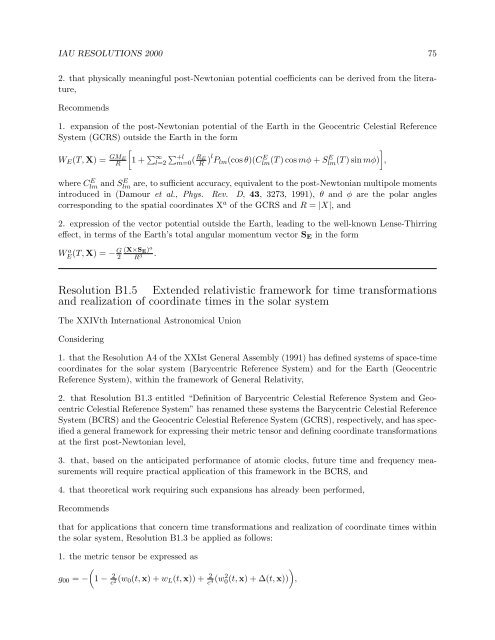USNO Circular 179 - U.S. Naval Observatory
USNO Circular 179 - U.S. Naval Observatory
USNO Circular 179 - U.S. Naval Observatory
Create successful ePaper yourself
Turn your PDF publications into a flip-book with our unique Google optimized e-Paper software.
IAU RESOLUTIONS 2000 75<br />
2. that physically meaningful post-Newtonian potential coefficients can be derived from the literature,<br />
Recommends<br />
1. expansion of the post-Newtonian potential of the Earth in the Geocentric Celestial Reference<br />
System (GCRS) outside the Earth in the form<br />
WE(T, X) = GME<br />
<br />
R 1 + ∞ +l<br />
l=2 m=0 ( RE<br />
R )lPlm(cos θ)(CE lm (T ) cos mφ + SE <br />
lm (T ) sin mφ) ,<br />
where C E lm and SE lm<br />
are, to sufficient accuracy, equivalent to the post-Newtonian multipole moments<br />
introduced in (Damour et al., Phys. Rev. D, 43, 3273, 1991), θ and φ are the polar angles<br />
corresponding to the spatial coordinates Xa of the GCRS and R = |X|, and<br />
2. expression of the vector potential outside the Earth, leading to the well-known Lense-Thirring<br />
effect, in terms of the Earth’s total angular momentum vector SE in the form<br />
W a E<br />
(T, X) = − G<br />
2<br />
(X×SE) a<br />
R3 .<br />
Resolution B1.5 Extended relativistic framework for time transformations<br />
and realization of coordinate times in the solar system<br />
The XXIVth International Astronomical Union<br />
Considering<br />
1. that the Resolution A4 of the XXIst General Assembly (1991) has defined systems of space-time<br />
coordinates for the solar system (Barycentric Reference System) and for the Earth (Geocentric<br />
Reference System), within the framework of General Relativity,<br />
2. that Resolution B1.3 entitled “Definition of Barycentric Celestial Reference System and Geocentric<br />
Celestial Reference System” has renamed these systems the Barycentric Celestial Reference<br />
System (BCRS) and the Geocentric Celestial Reference System (GCRS), respectively, and has specified<br />
a general framework for expressing their metric tensor and defining coordinate transformations<br />
at the first post-Newtonian level,<br />
3. that, based on the anticipated performance of atomic clocks, future time and frequency measurements<br />
will require practical application of this framework in the BCRS, and<br />
4. that theoretical work requiring such expansions has already been performed,<br />
Recommends<br />
that for applications that concern time transformations and realization of coordinate times within<br />
the solar system, Resolution B1.3 be applied as follows:<br />
1. the metric tensor be expressed as<br />
<br />
g00 = −<br />
1 − 2<br />
c 2 (w0(t, x) + wL(t, x)) + 2<br />
c 4 (w 2 0<br />
<br />
(t, x) + ∆(t, x)) ,


